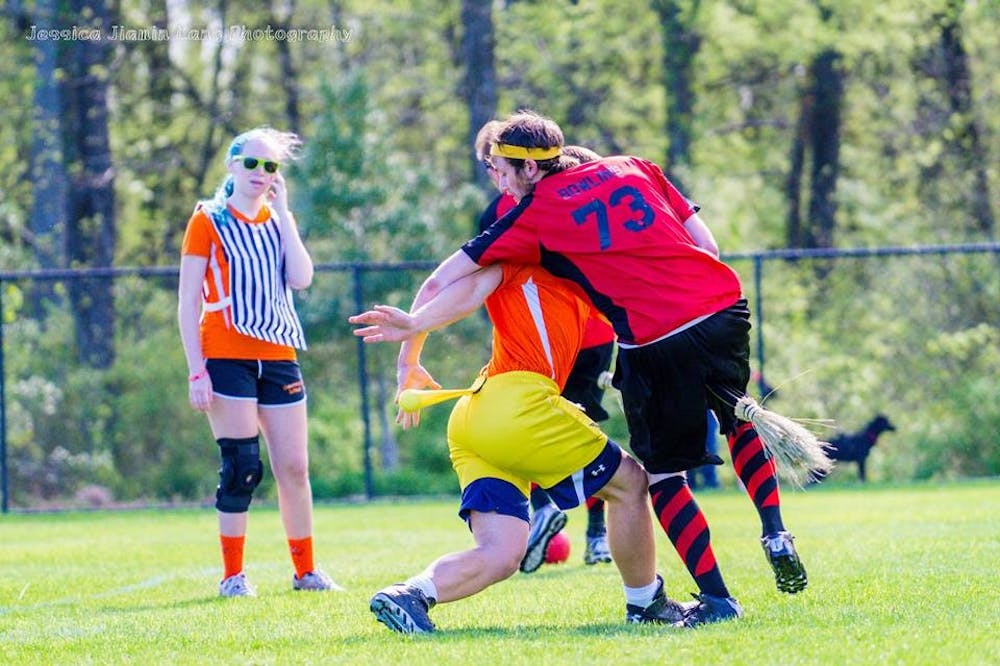Three chasers score goals worth 10 points each with a volleyball called the quaffle. They advance the ball down the field by running with it, passing it to teammates, or kicking it. Each team has a keeper who defends the goal hoops. Two beaters use dodgeballs called bludgers to disrupt the flow of the game by “knocking out” other players. Any player hit by a bludger is out of play until they touch their own goals. Each team also has a seeker who tries to catch the snitch. The snitch is a ball attached to the waistband of the snitch runner, a neutral athlete in a yellow uniform who uses any means to avoid capture. The snitch is worth 30 points and its capture ends the game. If the score is tied after the snitch catch, the game proceeds into overtime.
During play, players are forbidden from taking certain actions, or fouls. Players who commit fouls face different consequences depending on the severity of the offense. A back to hoops foul indicates that a player must stop and return to their hoops, as though knocked out. A yellow card indicates that a player must spend one minute in the penalty box. A red card indicates that a player is barred from the rest of the game.
via https://www.usquidditch.org/about/rules
Editor's note: Tyler Walker writes for the Daily News
The Quidditch World Cup is no longer an impossible dream for “Harry Potter” fans. In fact, two Ball State Quidditch team members have applied to play in the 2016 World Cup in Frankfurt, Germany.
Jason Bowling, a junior computer technology major, and Tyler Walker, a senior journalism major, have been playing since their freshman year. After a lengthy application process, both are anxiously waiting to hear back in mid-April.
“It’s been stressful,” Bowling said. “I’ve started saving money, but it’s been hard trying to figure out if there are certain things I need to do before I go, because I won’t have time if I wait until April.”
Walker also said he has been stressed waiting for an answer.
“As soon as I finished the application, I thought, ‘Let me know about this right now,’” Walker said.
The application process included an essay, videos of the player in action and a letter of recommendation from a coach. A statement detailing how the player would raise funds to attend the match was also required, because all players fund their own trip.
Both Bowling and Walker were “Harry Potter" fans growing up. The opportunity to play the sport was too good to pass up when looking for organizations to join.
Real-life quidditch is as similar to J.K. Rowling’s fictional game as possible. Players are required to have a broom between their legs at all times, according to the official rules of U.S. Quidditch.
There are seven team members who play four different positions, and three types of balls. Bowling is a seeker, meaning it is his job to run after the snitch, which is a runner dressed in yellow with a Velcro tail attached to their shorts. Catching the snitch is worth 30 points.
Walker is one of two beaters. His job is to throw dodgeballs, called bludgers, at the opposing team to “knock them off their brooms.” When players are hit by a bludger, they have to run to their goal posts and touch one before returning to play. If they are holding a ball, they have to drop it.
Other players include chasers, who score the goals with a volleyball called the quaffle, and the keeper, who defends the goalposts. There are three chasers on the field at a time, who can pass the quaffle among themselves. Each goal is worth 10 points, and there are three goal hoops of varying heights. Goals can be scored by throwing or kicking the quaffle through one of the goal hoops.
Bowling said he only began thinking about going to the World Cup after the summer. Tyler Macy, a previous Ball State seeker, taught Bowling and had been the seeker for the first Team USA.
“I decided to go for it,” Bowling said. “I thought, why not give it a shot?”
The U.S. Quidditch team is made of 21 players, including alternates. The members must come from different regions of the U.S. and “represent a diversity of positions, genders and geography.” The selection committee consists of a team manager, four U.S.Q. regional coordinators, one U.S.Q. gameplay coordinator and three community members.
Last semester, Bowling had a 4-1 record for catching the snitch in a “swim situation.” A swim situation is catching the snitch when the 30 points will decide the outcome of the game. The team tied for fifth place at their regional competition, and will advance to the National Cup in South Carolina.
“This has been such a fun season,” Walker said. “We’re going to nationals, and we have a really good team. I’ve had so much fun.”
Bowling and Walker have been practicing as normal, preparing for the National Cup in April. At practice, Bowling acts as a chaser, but said he has an advantage seeking because of his long arms. Walker’s biggest challenge was finding a friend to help him gather video for his application, because beater play isn’t typically followed, he said.
The players expressed having similar feelings if they were to be chosen for the team.
“[Being chosen] would be just incredible,” Walker said. “It would be an honor to play for Team USA.”
Bowling called the opportunity both an honor and a reward.
“There are 4,000 players in the USQ, and only 21 are chosen for Team USA,” he said. “It would be a reward because it means all the hard work and training pays off.”





